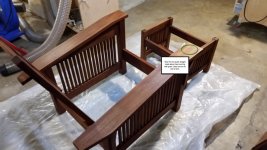This isn't exactly a finishing topic, but I wasn't sure where else it could fit. I made a bent arm Morris chair and one of the arms. right where the sitter will rest their hands, has this annoying super fine crack. I tried taking a picture, but you can't see it. It runs deep, but NOT to the end of the arm. The wood is otherwise pretty solid and there is no way to open the crack even a tiny bit to squirt in some glue, such as CA. I don't want to risk cracking it more. I have sanded this down and you can barely feel it, but I know the wood will move/expand and once again the crack will be felt. Any ideas? Apply some CA or???
Sigh... this is one of those woodworking lessons of fixing a mistake. The chair was a real killer with 70+ little mortises, those bent arms, making the legs... I can't have the thing ruined by feeling that darn crack every time I sit in it. Plus it is the ONLY thing I have made for myself in ten years! Life is not fair!
Sigh... this is one of those woodworking lessons of fixing a mistake. The chair was a real killer with 70+ little mortises, those bent arms, making the legs... I can't have the thing ruined by feeling that darn crack every time I sit in it. Plus it is the ONLY thing I have made for myself in ten years! Life is not fair!

